|
W Hya (IRAS 13462-2807) - A nearby O-rich Mira star
Basic parameters:
RA(J2000) = 13h49m01.998s (Hipparcos cat:
Perryman et al., 1997A&A...323L..49P)
DEC(J2000) = -28d22m03.49s (Hipparcos cat: Perryman
et al., 1997A&A...323L..49P)
Distance = 78+-6 pc (new Hipparcos cat for LPVs:
Knapp et al., 2003A&A...403..993K)
115 pc (old Hipparcos cat: Perryman et al., 1997A&A...323L..49P)
Proper motion: dRA =
-49.05 mas/yr; dDEC = -59.58 mas/yr (Hipparcos cat:
Perryman et al., 1997A&A...323L..49P)
L* = 5400 Lsun (?)
11050 Lsun (Zubko &
Elitzur, 2000ApJ...544L.137Z)
Teff = 2500 K (Haniff et al., 1995MNRAS.276..640H)
R* = 1.2x10^14 cm = 1.8 AU (?)
3.9x10^13 cm = 0.58 AU (Zubko
& Elitzur, 2000ApJ...544L.137Z)
M* = 1 Msun (?)
Mlr = 1.8(+-0.7) x 10^-7 Msun/yr (Young, 1995ApJ...445..872Y)
2.3x10^-6 Msun/yr (Zubko
& Elitzur, 2000ApJ...544L.137Z)
P = 382 day (?)
Vexp = 8.0+-0.2 km/s (Young, 1995ApJ...445..872Y)
Radio Observations
 | Observation of radio continuum and H2O maser revealed stellar
surface with diameter of 0.09" and
H2O maser ring with diameter of 0.3" towards W Hya.
(from Reid & Menten, 1990ApJ...360L..51R) |
 | They used PdBI to map the SiO v = 0 J = 2-1 emission towards a sample of AGB
stars (including W Hya). They found that SiO
emission region size doesn't change with velocity for most sources (except
IRC +10216), which they argued to be the result of a large
wind acceleration zone. (from Lucas et al., 1992A&A...262..491L) |
 | A CSO CO 3-2 survey to a sample of nearby Mira stars (< 500pc)
found 36 CO CSEs among 66 stars. Average Vexp=7.0 km/s,
only about 1/2 of that of IR selected Miras. Stars earlier than M5.5 were
all non-detections. Vexp anticorrelated with T*, Mlr correlated with
IR L*, and show power law relation to Vexp, but not with IR colors.
Several stars with extende dust envelope show no CO (R Cen & R Car). (from Young, 1995ApJ...445..872Y) |
 | They observed the 761 and 1100 um submm continuum
of 13 AGB stars, including W Hya. (from van der
Veen et al., 1995A&A...295..445V) |
 | Simultaneous MERLIN observations of all stokes parameters of OH 1665-
and 1667-MHz maser lines in W Hya were
presented. Vsys = 40+-1 km/s, Vexp = 5.2+-1.2 km/s.
The 1665 MHz masers were located in two clumps about 0.55"
away from the central star (80 AU @ dist = 115 pc) with a position
angle of about 90 deg. The 1667 masers were
located in a three times larger area with blue masers to the north and red
masers to the south of the central star. The two masers arise from different
area. The velocities of SiO, H2O, OH masers and CO lines observed at five
radial distances revealed a logarithmic velocity
gradient of dln(V)/dln(r) = 0.25 and 0.21 in the 1665 and 1667 MHz
maser regions, respectively. The acceleration within tens of stellar radii
can not be explained by classical radiation driven wind model, as found in VX Sgr by Chapman & Cohen (1986). (from Szymczak
et al., 1998MNRAS.297.1151S)
(figures: left --
polarization spectra of mainline OH masers; right --
spatial distribution of OH maser I stokes components.)
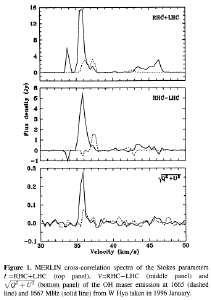 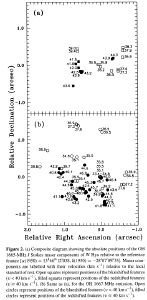 |
 | CSO observations of CO
3-2 and 4-3 in 45 AGB stars found 20% of double wind stars
and 6 stars with highly asymmetrical line
profiles. (from Knapp et al., 1998ApJS..117..209K)
(fig: CO 3-2 spectrum)
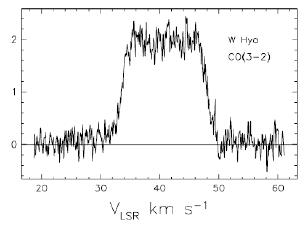 |
 | SiO and HCN line observations detected them in almost all their 30 M, S, C
type AGB stars. HCN line ratios support non-LTE chemistry to produce HCN.
HCN/SiO ratio separate O stars from C stars. (from Bieging et al., 2000ApJ...543..897B)
(figs: left -- HCN 3-2 spectrum; right -- HCN 4-3 spectrum)
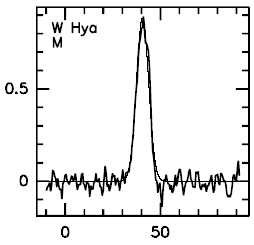 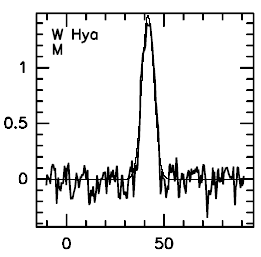 |
 | They monitored both the circular and linear polarization of the OH 1665 and
1667 MHz masers in three SR RT Vir, R Crt and W
Hya. (from Szymczak et al., 2001A&A...379..884S) |
 | They used VLBA to determine the proper motion and parallax
to four AGB stars: U Her, R
Cas, S CrB and W
Hya, but the last object showed additional motion possibly related to
stellar pulsation. (from Vlemmings et al., 2003A&A...407..213V) |
 | Weak 1612 MHz OH masers were detected in
three SR variables: SRb stars RT Vir and R Crt, as
well as the SRa W Hya. (from Etoka et al., 2003A&A...403L..51E) |
 | They detected for the first time maser lines
from 28SiO, v=0,1-0 transition in six evolved
stars using VLA: M-type stars IRC +10011, o Ceti, W Hya, RX Boo, NML Cyg, and R Cas and the S-type star χ
Cyg. (from Boboltz & Claussen, 2004ApJ...608..480B) |
 | They detected ortho-H2O 1_10-1_01 transition
at 557 GHz with Odin
satellite. They estimated a mass loss rate of (2.5+-0.5)x10^-7
Msun/yr and a [H2O/H2] = (2.0+-1.0)x10^-3.
Water ice evaporation was invoked to explain
the very high H2O abundance. (from Justtannont et al., 2005A&A...439..627J) |
 | They monitored multiple rotational SiO masers in various vibrational states towards
some 10 late-type stars, including W Hya. They
discussed line their overlap behavior. (from Kang et al., 2006ApJS..165..360K) |
 | They detected (using VLA) 43GHz radio atmosphere of similar diameter of
5.6 AU around Mira variables o Ceti, R Leo and W Hya. The 43 GHz continuum
emission is consistent with an opacity from H^- f-f emission with T = 1600 K.
The continuum images is circular for o Ceti, but elongated for R Leo and W
Hya. The zero baseline fluxes were 5, 4, 8 mJy for the three stars
respectively. SiO masers show partial ring of diameter of 8 AU. (from Reid
& Menten, 2007ApJ...671.2068R) |
 | They detected multi-transitions of submillimeter H2O
masers in two LPVs: R Leo and W Hya. They detected the 533-440
maser transition near 475 GHz for the first time. (from Menten et al., 2008A&A...477..185M) |
Optical/IR Observations
 | IRAS 60 and 100 um image showes huge dust shell with diameter of 30-40
arcmin (~ 1 pc @ dist = 115 pc) centered
around W Hya. (from Hawkins, 1990A&A...229L...5H)
(figure: IRAS 100um image of W Hya. North is
up, east to the left. The long arrow pointed to direction of the Galactic
plane. The box with short arrow indicate the IRAS detector size of 3'x4.5'
and direction of the IRAS scan.)
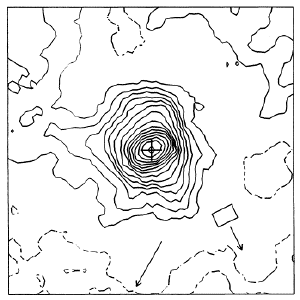 |
 | They use the HST interferometer -- Fine Guidance Sensor to measure the diameter of R Leo and W Hya in two orthogonal direction. They revealed that
both stars are not spherical. (from Lattanzi et
al., 1997ApJ...485..328L) |
 | A physical model of W
Hya was constructed by solving the coupled equations of hydrodynamics
and dust radiative transfer. The detailed IR radiation model was proved to
be critical factor in reproducing the IR H2O emission
lines. They derived Mlr = 2.3x10^-6 Msun/yr,
[H2O/H2] = 1x10^-4, ortho/para = 1:1.3. (from Zubko & Elitzur, 2000ApJ...544L.137Z) |
 | ISO spectra of W Hya were analysed. Model
fitting gives Mlr(dust) = 3x10^-10 Msun/yr. IR
absorption lines of H2O, OH, CO, CO2,
SiO, and SO2 from different gas layers. A CO2
layer of 450K is found to be in non-LTE. (from Justtanont et al., 2004A&A...417..625J) |
 | They presented NIR Keck aperture masking monitoring observations of six
Mira variables: ο Cet, R Leo, R Cas, W Hya, χ Cyg, and R
Hya. They gave light curves for angular diameter variations. The S-type Mira
Chi Cyg behave differently from those M-type Miras and need to explain.
(from Woodruff et al., 2008ApJ...673..418W)
(figures: left-- light
curves of W Hya; right-- NIR visibility of W Hya)

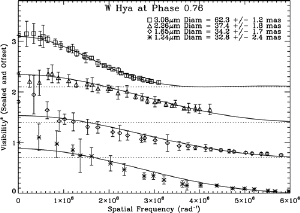 |
Physical Model
 | A physical model of W
Hya was constructed by solving the coupled equations of hydrodynamics
and dust radiative transfer. The detailed IR radiation model was proved to
be critical factor in reproducing the IR H2O emission
lines. They derived Mlr = 2.3x10^-6 Msun/yr,
[H2O/H2] = 1x10^-4, ortho/para = 1:1.3. (from Zubko & Elitzur, 2000ApJ...544L.137Z) |
|
![]()